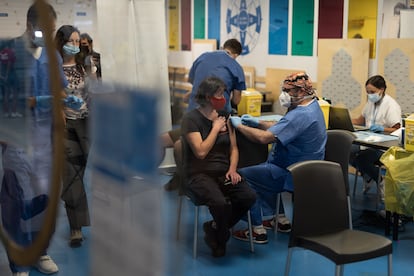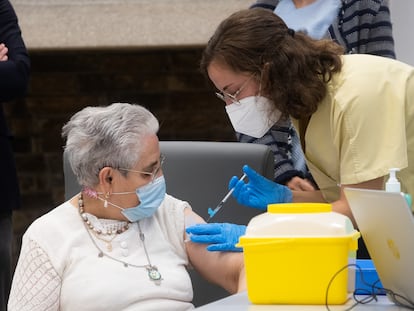Spain’s coronavirus transmission rates fall to ‘low risk’ level for the first time since July 2020
The national incidence has dropped below 50 cases per 100,000 inhabitants, prompting most regions to lift restrictions on social activity

Spain is now at “low risk” from the coronavirus. According to the latest figures, released Thursday evening, the 14-day cumulative number of cases per 100,000 inhabitants has fallen to 48.92. This is the first time since July 28, 2020 that the incidence rate has dropped below 50 cases, the threshold for a low risk situation, according to Spain’s coronavirus alert system.
The fall in contagions combined with hospital occupancy rates that are also considered “low” have placed Spain in a situation similar to what was seen after the strict home lockdown in spring 2020. The country is now detecting fewer coronavirus cases than most countries in the European Union. This is despite the fact that there are minimal restrictions on social activity.
Spain’s regions, which are in charge of their healthcare systems, coronavirus restrictions and vaccination drives, are increasingly moving towards the so-called new normality. The strictest measures such as the closure of nighttime venues and limits on capacity and opening hours are being lifted, but this has not yet led to a rise in cases. Most experts agree that, barring a new mutation of the virus, Spain has left the worst of the pandemic behind. They, however, are calling on the public to not lower their guard and for the epidemiological monitoring system to be strengthened so that it can quickly address any possible coronavirus outbreaks.
The incidence rate of 50 cases per 100,000 inhabitants is more a psychological milestone than a practical one. Indeed, nothing will change in Spain just because it has reached this goal. But it puts the epidemiological curve on track to fall below 25 cases per 100,000 inhabitants – the threshold the scientific community considers to indicate the spread of the virus is under control. Alberto Infante, emeritus professor of international health at the National Health School of the Carlos III Health Institute, defines the situation as “a moment of optimism with prudence.” “We have a low incidence rate, but this hides the enormous differences among regions and age groups,” he says.
The northwestern region of Galicia, for example, has an incidence rate of 19, compared to 79 in Cantabria and around 75 in Catalonia and Aragón. The pandemic is not over, warns Daniel López-Acuña, the former director of emergencies at the World Health Organization (WHO): “The average incidence of 50 is not a magic number nor a safe number to aspire to. The virus remains active and we cannot hasten the relaxation of restrictions, especially in schools.” The 14-day cumulative number of cases per 100,000 inhabitants among Spain’s under-12 population, the only age group for whom no vaccine has been approved, is 82.
The regions, however, are rushing to lift coronavirus restrictions. Outside of schools, there are few measures beyond the use of face masks in enclosed spaces, the recommendation to ventilate indoors and social distancing rules. Catalonia announced this week that universities will return to 100% in-person classes and that the nighttime venues will reopen on Friday. Patrons, however, will need to present a Covid certificate certifying that they have either had Covid-19 over the last six months, tested negative for the coronavirus via a PCR test or are vaccinated. This measure still needs to be approved by the Catalan High Court. The Balearic Islands are also set to resume nightlife on Friday. A Covid certificate will also be required to enter these venues.
Up until now, these two regions were the only ones that had not allowed nightclubs to reopen. Madrid, meanwhile, has lifted all capacity restrictions on the food and entertainment sector, while in Spain’s Basque Country, outdoor stadiums can now open at full capacity (indoor sports centers such as basketball stadiums remain at 80% capacity). The health chief of Andalusia, Jesús Aguirre, said on Tuesday that restrictions on capacity and opening hours are expected to be lifted in around two-thirds of the southern region on Friday.
Pedro Gullón, from the Spanish Epidemiology Society, believes that it is reasonable “and even desirable” for restrictions to be lifted. But he says that it must be done coherently across all areas: “If we are acting in places with a very high economic impact, such as bars, which I am not criticizing, it doesn’t make sense that [restrictions] are not lifted in other areas such as libraries or hospital visits, which has a high social impact.”
López-Acuña does not want the use of face masks or social distancing to be relaxed. “Variants could emerge that are resistant to the vaccine. We have to be very cautious at a time when other respiratory viruses are appearing,” he says. Winter is usually the season that sees the convergence of other microorganisms that cause respiratory illnesses, such as the flu or respiratory syncytial virus, which cause most cases of bronchiolitis in small children.
Falling hospitalizations
Experts are closely looking at the situation in Spain’s hospitals. With the large majority of the population fully vaccinated against Covid-19, the number of coronavirus cases in any new wave of infections or possible outbreak will not be as important as the pressure on the healthcare system. This pressure has been easing since August. On Thursday, there were 2,088 people admitted to hospital with Covid-19, of whom 551 were in intensive care units (ICUs). These are very low figures considering that more than 30,000 people were hospitalized in January during the third coronavirus wave. Some experts worry, however, that the potential convergence of other respiratory viruses between autumn and winter could put the healthcare system under greater pressure.
Infante argues that epidemiological monitoring of the coronavirus must be strengthened. He believes that the incidence rate will remain at the 50-cases threshold for some time. Indeed, in the last few weeks, the fall in contagions has slowed slightly: between September 13 and 17, the incidence rate dropped 21.46%, while last week, it only fell 11.48%. A data point that helps to predict trends is the seven-day cumulative incidence rate (CI). Although it is more incomplete than the 14-day figure, as it does not reflect late reported cases, it helps to anticipate how transmission rates could change in the future. On Thursday the seven-day cumulative number of cases per 100,000 inhabitants stood at 20, nearly half the 14-day CI, meaning it is likely the latter figure will continue to fall.
Like Infante, Gullón believes that Spain must now focus on improving its monitoring system and taking preventive action. “Perhaps we shouldn’t be either triumphant, thinking we are free of risk, or defeatist, trying to maintain limits that people are very tired of. Now that there are few cases is the time to act with more epidemiological intelligence so that, if problems do emerge, such as a virus that resists the vaccines or if these lose their effectiveness, we can act early,” he says.
Tu suscripción se está usando en otro dispositivo
¿Quieres añadir otro usuario a tu suscripción?
Si continúas leyendo en este dispositivo, no se podrá leer en el otro.
FlechaTu suscripción se está usando en otro dispositivo y solo puedes acceder a EL PAÍS desde un dispositivo a la vez.
Si quieres compartir tu cuenta, cambia tu suscripción a la modalidad Premium, así podrás añadir otro usuario. Cada uno accederá con su propia cuenta de email, lo que os permitirá personalizar vuestra experiencia en EL PAÍS.
¿Tienes una suscripción de empresa? Accede aquí para contratar más cuentas.
En el caso de no saber quién está usando tu cuenta, te recomendamos cambiar tu contraseña aquí.
Si decides continuar compartiendo tu cuenta, este mensaje se mostrará en tu dispositivo y en el de la otra persona que está usando tu cuenta de forma indefinida, afectando a tu experiencia de lectura. Puedes consultar aquí los términos y condiciones de la suscripción digital.
More information
Últimas noticias
Petro claims the ELN was the target of US attack in Venezuela
Maduro counterattacks Trump with rhetoric and announces downing of nine drug trafficking aircraft
‘Ecce Homo’: The miraculous disaster that made a small Spanish town famous
Return to sex testing at the Olympics: IOC edges closer to banning transgender women
Most viewed
- Sinaloa Cartel war is taking its toll on Los Chapitos
- Oona Chaplin: ‘I told James Cameron that I was living in a treehouse and starting a permaculture project with a friend’
- Reinhard Genzel, Nobel laureate in physics: ‘One-minute videos will never give you the truth’
- Why the price of coffee has skyrocketed: from Brazilian plantations to specialty coffee houses
- Silver prices are going crazy: This is what’s fueling the rally










































